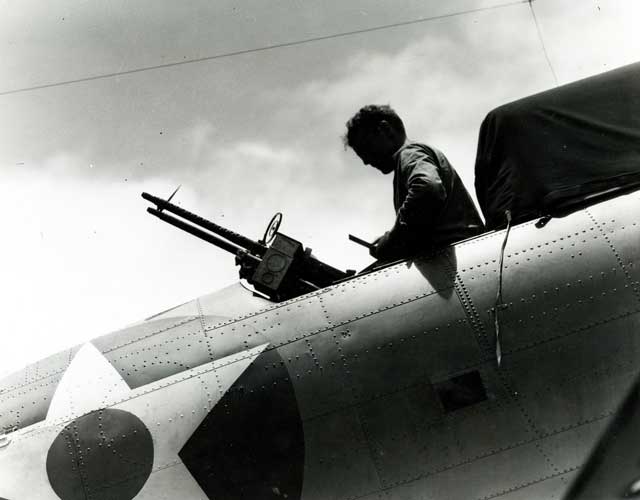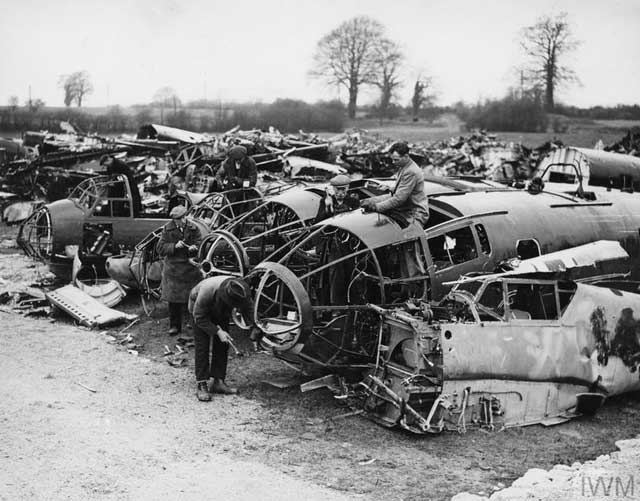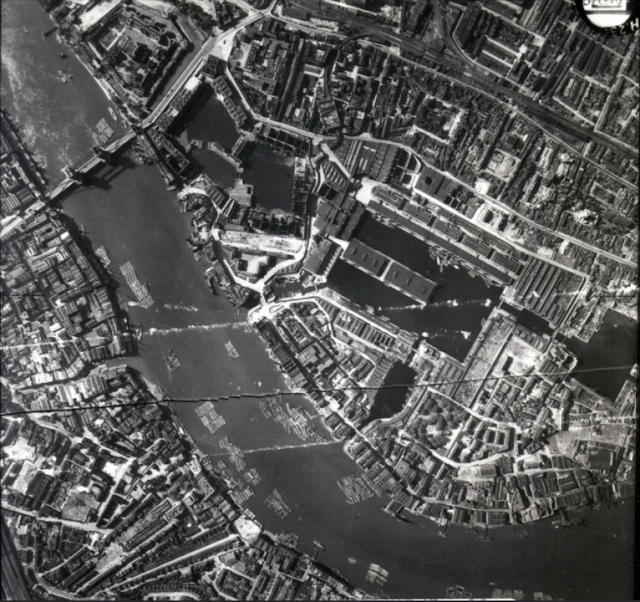Tuesday 24 February 1942
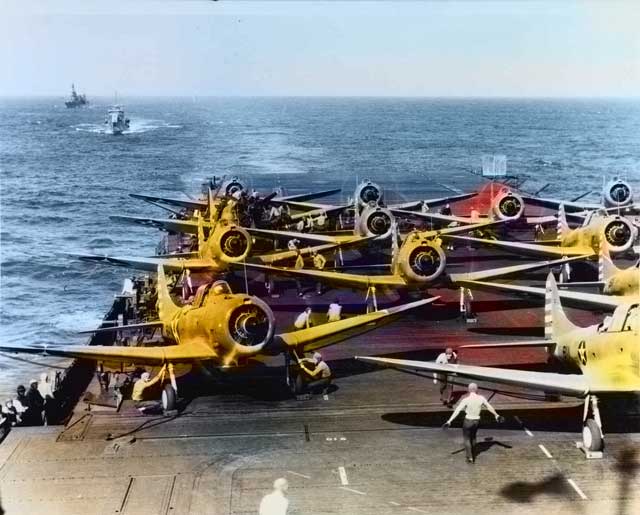 |
| Douglas SBD-3 Dauntlesses on the deck of USS ENTERPRISE (CV-6) prepare for the Wake Island Raid, 24 February 1942. USS Northampton is visible in the background (colorized, US Navy). |
 |
| "View taken aboard USS ENTERPRISE (CV-6) showing Grumman F4F-3 Wildcats preparing for takeoff." Naval History and Heritage Command. |
US Navy submarine USS Swordfish continues its evacuation of highly placed individuals in the Philippines. Having already evacuated Manuel Quezon, today it embarks U.S. High Commissioner to the Philippine Islands Francis B. Sayre and his party of 12, plus five sailors, at Manila Bay. Swordfish heads for Fremantle, Western Australia, due to the ongoing evacuation at Java.
As they have done previously, the Japanese perform some surreptitious aerial reconnaissance over Pearl Harbor. Japanese submarine HIJMS I-9 sends its Yokosuka E14Y1 Navy Type 0 Small Reconnaissance Seaplane over the naval base. As in previous overflights, this one goes undetected by the US military.
 |
| The Melbourne, Australia, Argus reports on the recent Darwin air aid, 24 February 1942. |
European Air Operations: The RAF sends 42 Hampdens and 9 Manchester bombers on minelaying operations near the Frisian Islands and off Whilehlmshaven and Heligoland. Two Hampdens fail to return. An additional five bombers drop leaflets on France and Belgium.
U-158 (Kptlt. Erwin Rostin), on its first patrol out of Heligoland, attacks ONS-67 at 08:55. His victim is the 8032-ton British tanker Empire Celt, which is hit by two torpedoes. There are six dead and 47 survivors. The Empire Celt eventually breaks in two, with the stern portion remaining afloat at least until 4 March. U-158 later damages 8146-ton British tanker Diloma at 10:35 with one torpedo, but the tanker is able to make it to Halifax under reduced power. All 60 people on Diloma survive.
 |
| MV Eidanger, sunk on 24 February 1942. |
- 8009-ton British tanker Anadara (damaged, then sunk)
- 5578-ton British freighter Inverarder
- 9432-ton Norwegian tanker Eidanger
7005-ton freighter Empire Hail is torpedoed and sunk at 01:45 east of St. John's. This sinking is usually ascribed to U-94 (Kptlt. Herbert Kuppisch), but this may not be accurate. In any event, all 49 men on board perish. These convoy battles can become quite difficult to break down and figure out exactly which U-boat sank which ship. Empire Hail either is a straggler or has been dispersed from Convoy ON-66.
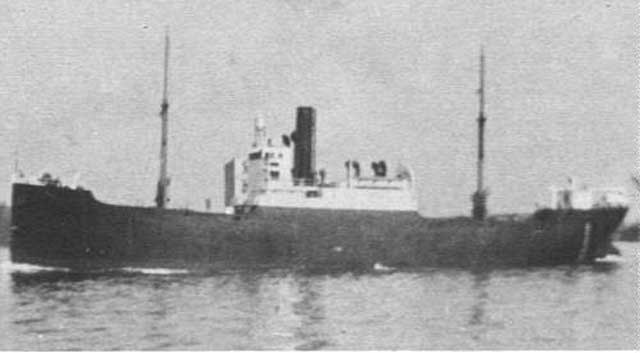 |
| Norlavore, sunk on or about 24 February 1942. |
U-752 (Kptlt. Karl-Ernst Schroeter), on its fourth patrol and en route from Bergen to La Pallice, reports torpedoing a tanker in Convoy HX 175. However, it is unclear which ship is involved, if any.
 |
| Paris-soir newspaper, 24 February 1942. |
Battle of the Black Sea: Soviet submarine Shch-213 sinks two ships near the mouth of the Bosphorus. One is the Struma, discussed below. The other is 454-ton Turkish naval auxiliary Cancaya, off Kara Burnu. Everyone survives.
 |
| Stjepan Filipovićin on the gallows (United States Holocaust Museum). |
Spy Stuff: The Soviets and Germans have been vying for the support of Turkey, and today the Soviet NKVD decides to do something about it in a very roundabout way. They sponsor a Macedonian student in Ankara to assassinate German Ambassador to Turkey Franz von Papen. Exactly why the Soviets want to assassinate von Papen is a mystery, because he is not particularly influential within the Third Reich's upper reaches, but maybe they don't know that. The Soviets may be trying to impress the Turks with their ability to affect events in Turkey. Perhaps they just figure that a former German Chancellor (for about five months in 1932) is a worthy target. The student, in a scene somewhat foreshadowing a latter assassination attempt on Reinhard Heydrich, first tries to shoot von Papen. When that fails, he tries to blow von Papen up. Unfortunately for the student and the Soviets, the student mistimes his throw of the bomb and it explodes in his hand, killing him. Von Papen thus continues on as ambassador and is credited with some diplomatic moves that don't sway the Turks to the Axis but do at least keep it neutral.
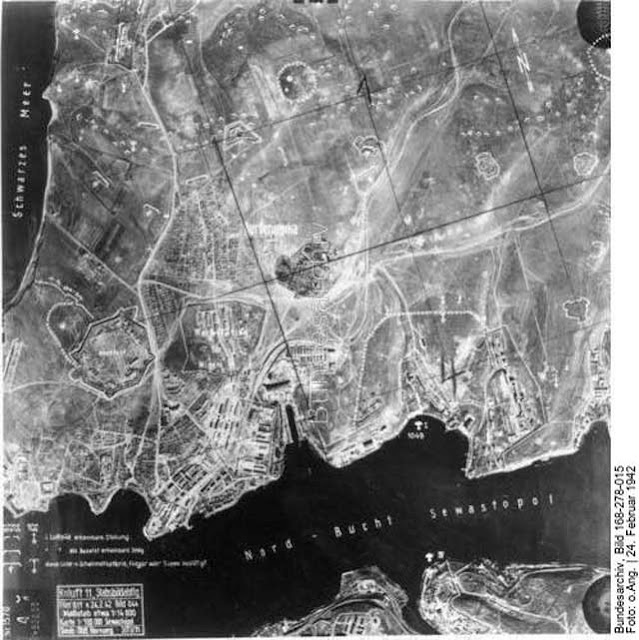 |
| A Luftwaffe aerial reconnaissance photo of Sevastopol on 24 February 1942. The Red Army continues to hold out in Sevastopol against General Manstein's 11th Army (Federal Archive Picture 168-278-015). |
Here speaks a voice from America. Every day at this time we will bring you the news of the war. The news may be good. The news may be bad. We shall tell you the truth.VOA is intended for non-US audiences and is designed to give the Allied version of facts and to counter enemy propaganda. While perhaps not as influential as the nightly BBC broadcasts to Occupied Europe, VOA at least provides a face to the United States war effort there. This begins a long history of VOA throughout the Cold War that continues to this day, now broadcast in English and fifty-two other languages.
Applied Technology: Apparently for the first time, the US military becomes interested in the new medium of television. The Bureau of Aeronautics of the US Navy begins the process of procuring television equipment that is capable of operating from airplanes. The Navy isn't quite sure what to do with television but has vague plans to use it for radio-controlled remote operation of weapons and aircraft.
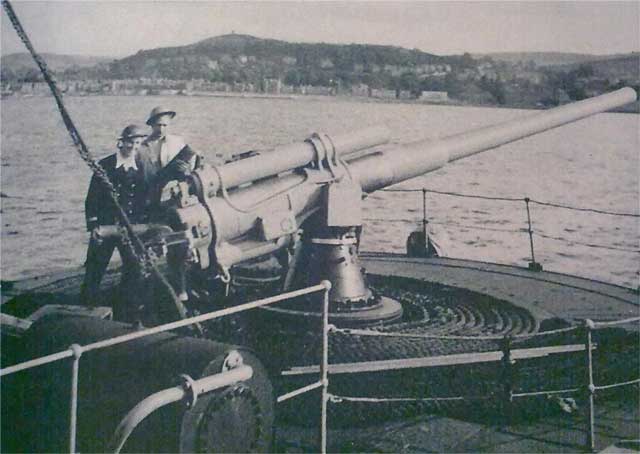 |
| Third Officer John Norie and the senior cadet of the motor tanker Anadara. Later sunk with the loss of all hands (Wreck Site). |
US Military: Major General Joseph Stilwell, Commanding General American Army Forces, China, Burma, and India, completes his journey from the United States to Karachi (now in Pakistan).
Under orders to head to India, U.S. Major General Lewis Brereton and his staff board two bombers and depart Melbourne, Victoria. Brereton's new position is as commander of the10th Air Force.
The USAAF makes big progress in building up its assets in Australia.
- Headquarters, 3rd Bombardment Group (8th, 13th, 89th, and 90th Bombardment Squadrons) arrives in Brisbane, Australia with A-20s.
- Headquarters, the 22nd Bombardment Group (Medium) (2nd, 19th, and 33rd Squadrons and 10th Reconnaissance Squadron) with B-26s;
- Headquarters, 38th Bombardment Group (Medium) (70th and 71st Squadrons and 15th Reconnaissance Squadron with B-26s)
- 35th and 39th Pursuit Squadrons (both Interceptor), flying P-39s.
The 503rd and 504th Parachute Infantry Battalions are joined together to form the 504th Parachute Infantry Regiment at Fort Bragg, North Carolina. This unit later becomes famous in England as the "Red Devils." As a result of its renown, it will be allowed to wear a distinctive maroon beret that ultimately becomes standard wear for all paratroopers.
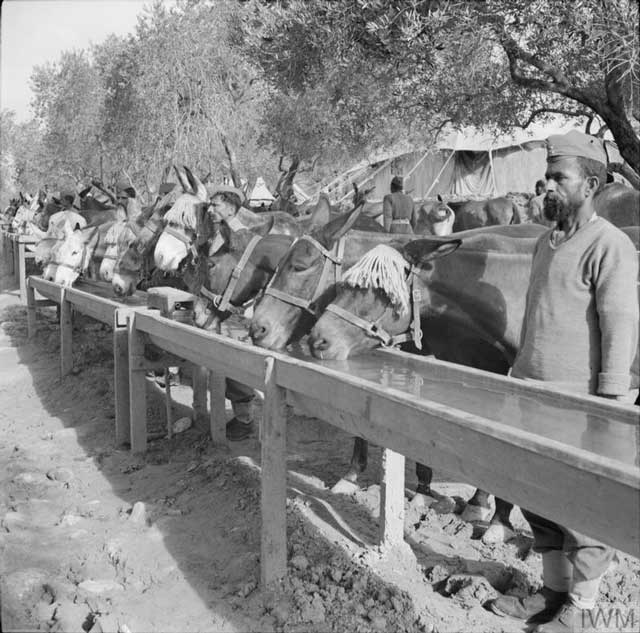 |
| Troops of one of the Indian mule pack companies watering their mules at drinking troughs in a camp in Lebanon, 24 February 1942. Exact location unknown. © IWM (E 8771). |
Holocaust: About 781 (this number has changed over time due to scholarship) Jewish refugees are drifting in the Black Sea off Yam Burnu in 240-ton Panamanian freighter MV Struma en route from Romania to Mandatory Palestine when disaster strikes. Soviet submarine Shch-213 torpedoes Struma, whose engines have failed, killing all of the refugees but one (David Stoliar) plus all 10 crewmen. The Soviet sub is under secret orders to sink all neutral and enemy shipping entering the Black Sea as part of a blockade of the region. Stollar eventually makes it to Palestine and passes away in 2014. Among other things, the Struma disaster becomes a rallying cry within Israel (after it is established) and a subject of recriminations within the British government.
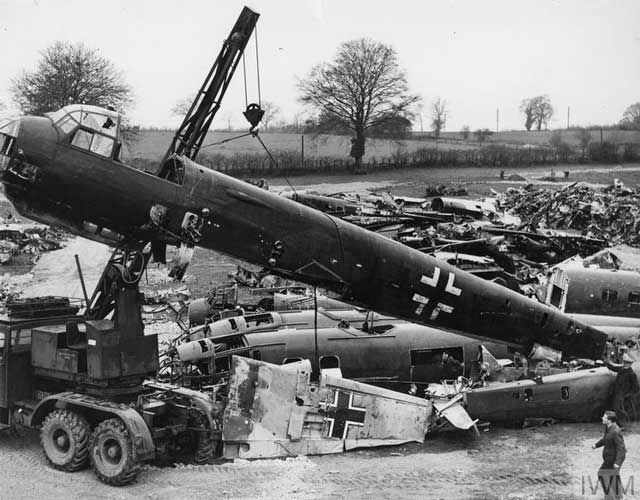 |
| "The wrecks of Luftwaffe aircraft in a British scrapyard, 24 February 1942. The fuselage of a Junkers Ju 88 is being lifted by a crane." © IWM (E (MOS) 56). |
German Homefront: Anton Drexler, who founded the German Worker's Party (DAP) which ultimately became the NSDAP on 24 February 1920, passes away from natural causes in Munich on 24 February 1942. Drexler, an almost forgotten historical figure, was the co-founder of the DAP in Munich on 5 January 1919. In September 1919, Drexler noticed a new member in the audience who got into a loud argument with another attendee. Impressed by this stranger, Drexler went up to the man, gave him a pamphlet, and encouraged him to join the DAP. The man was Adolf Hitler, and this was his first contact with the organization. Hitler received approval from his army superiors to join the DAP and quickly began raising its profile. Hitler did not replace Drexler as leader until July 1921. After that, Drexler left the party completely in 1923 and faded into obscurity. However, Drexler did later reestablish a minor connection with the NSDAP, though he never again attained any power.
 |
| Moses Anger, who is registered at Auschwitz on 24 February 1942. He will perish there on 3 March 1942 (Auschwitz Memorial). |
Future History: Joseph Isadore Lieberman is born in Stamford, Connecticut. After graduating from Yale University Law School, Joe (as everyone calls him) embarks on a legal career, then embarks on a political career. He is elected to the Connecticut Senate in 1970, where he serves for a decade, then serves as Connecticut Attorney General from 1983 to 1989. After that, Lieberman serves as US Senator from Connecticut from 1989 to 2013. Lieberman wins the 2006 Senate race running as an Independent rather than on his typical Democratic Party line. Lieberman is instrumental in the creation of the Department of Homeland Security (DHS) in 2002. Since leaving the Senate, Joe Lieberman has remained active in politics.
Paul Pond is born in Portsmouth, Hampshire, England. As Paul Jones, he becomes a popular radio personality in Great Britain, including presenting "The Blues Show" on BBC Radio 2 for 32 years up until April 2018. Paul Jones also records numerous albums, from "My Way" in 1966 (including the hit song "High Time") to "Suddenly I Like It" in 2015. Paul Jones remains active as of 2019.
Patricia Joanne "Jenny" O'Hara is born in Sonora, California. She becomes a noted stage, film, and television actress in the United States. She is particularly noted for being on numerous popular television series beginning in 1975 and continuing up to the time of this writing, though never becoming a celebrity. Jenny O'Hara remains active as an actress.
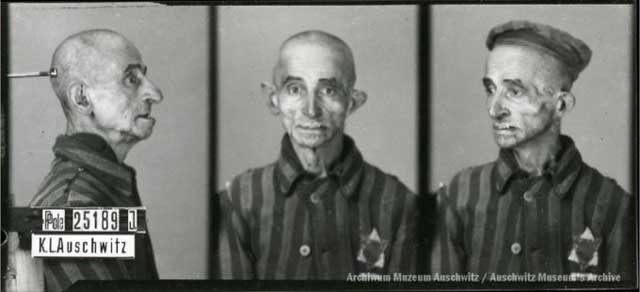 |
| Abraham Bienenstock, registered at Auschwitz on 24 February 1942. He will perish there on 28 February 1942. |
February 1942
February 1, 1942: The US Navy Strikes Back
February 2, 1942: Germans Recovering in Russia
February 3, 1942: Japanese Shell and Bomb Singapore
February 4, 1942: Battle of Makassar Strait
February 5, 1942: Empress of Asia Sunk
February 6, 1942: The Christmas Island Body
February 7, 1942: The Double-V Campaign
February 8, 1942: Japan Invades Singapore
February 9, 1942: French Liner Normandie Capsizes
February 10, 1942: US Car Production Ends
February 11, 1942: Tomforce Fails on Singapore
February 12, 1942: The Channel Dash
February 13, 1942: Japanese Paratroopers In Action
February 14, 1942: RAF Orders Terror Raids
February 15, 1942: Japan Takes Singapore
February 17, 1942: Indian Troops Defect to Japanese
February 18, 1942: Battle of Badung Strait
February 19, 1942: FDR Authorizes Internment Camps
February 20, 1942: O'Hare the Hero
February 21, 1942: Crisis in Burma
February 22, 1942: Bomber Harris Takes Over
February 23, 1942: Bombardment of Ellwood, California
February 24, 1942: US Raid on Wake Island
February 25, 1942: Battle of Los Angeles
February 26, 1942: Gneisenau Eliminated
February 27, 1942: Battle of Java Sea
February 28, 1942: Battle of Sunda Strait
2020
